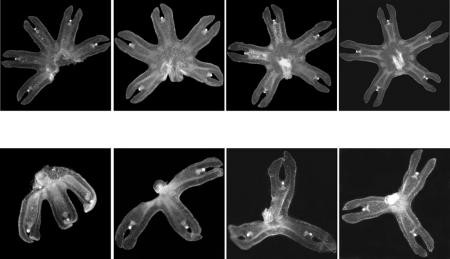Scientists have finally figured out the process how jellyfish are able to repair themselves with using a unique symmetrization method to restore its fragile body from damages.
Researchers from the California Institute of Technology (Caltech) namely Ty Basinger, Michael Abrams and Lea Goentoro examined how moon jellyfish or Aurelia aurita respond to such injuries that is similar to other injured hydra where they mainly investigated on its ephyra or juvenile stage for its simple anatomy.
During this stage in development, moon jellyfish possesses a body with eight appendages, perfectly symmetrical to each other within a disk shaped body. Scientists find this ideal in order to intensively examine how tissues regenerate.
During experiments, researchers carried out amputations over ephyra under anaesthesia in order to conduct injury simulations from wild predators. This resulted in jellyfish that spawned various numbers of limbs as opposed to the usual eight tentacles.
Researchers observed that moon jellyfish healed in a matter of a few hours however, the jellyfish did not grow out new arms from regenerated tissue in order to replace the missing arms. Instead, the ephyra adjusted the placement of its arms in order for it to be symmetrical with its body to be evenly distributed within two days of receiving injuries.
This process that involves the ability of the jellyfish to place its remaining arms in a symmetrical manner even if some of its appendages were cut out are also observed in three other species of ephyra jellyfish.
Goentoro confirms that this is a new strategy for self repair where other creatures just heal their wounds or regenerate ones that are lost however this is not applicable to the moon jellyfish. Instead of just healing the wound, they reorganize their remaining limbs to regain symmetry in their body.
Scientists believe that since jellyfish body structure possesses radial symmetry, it cannot distinguish its right side from its left side and this body type allows the jellyfish to move along the water and feed in the process.
Abrams explains this process when the jellyfish flaps its arms to move underwater. With this flapping motion, the jellyfish is able to move its appendages covered with thick substance that helps them to paddle in a continuous motion. This means that for the jellyfish to maintain a fluid motion underwater, it should not have huge gaps between its arms.
This new study also revealed that this jellyfish repairs its injuries by contracting their muscles to move their arms to achieve symmetrization instead of generating new cells to replace dead cells.
Scientists now gain new insights about how self repair works where it can also be applied in engineering bio materials that are capable of repairing itself via symmetrization. This new study is published in the journal Proceedings of the National Academy of Sciences.



























